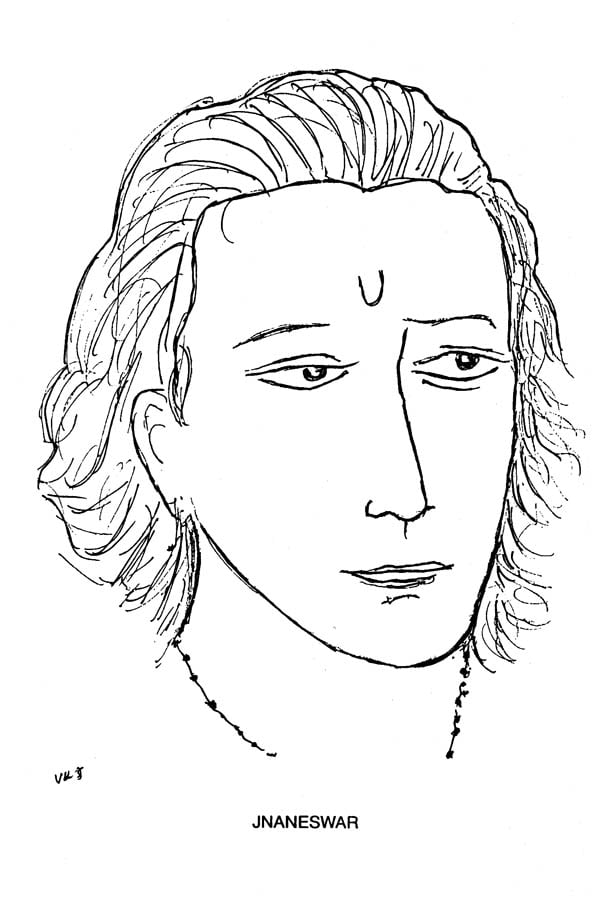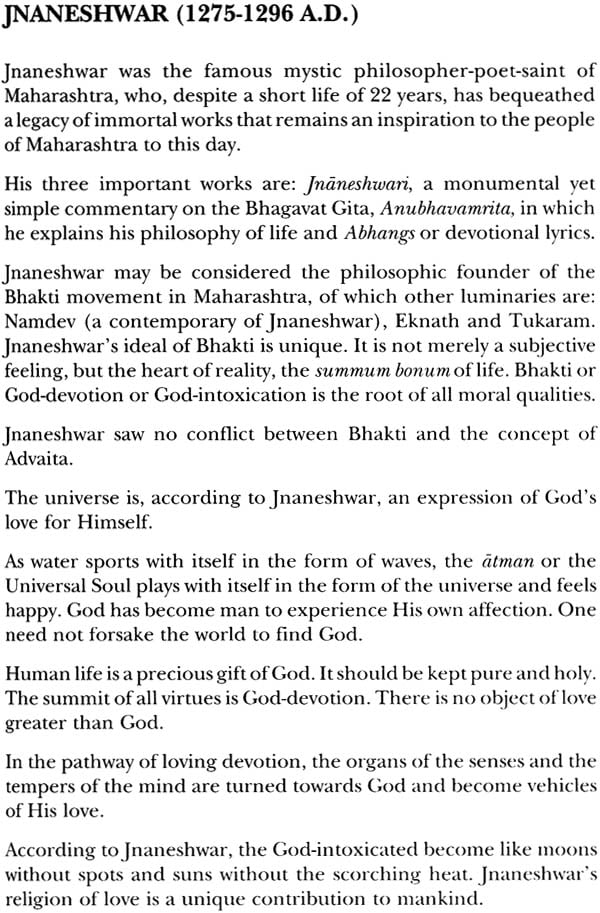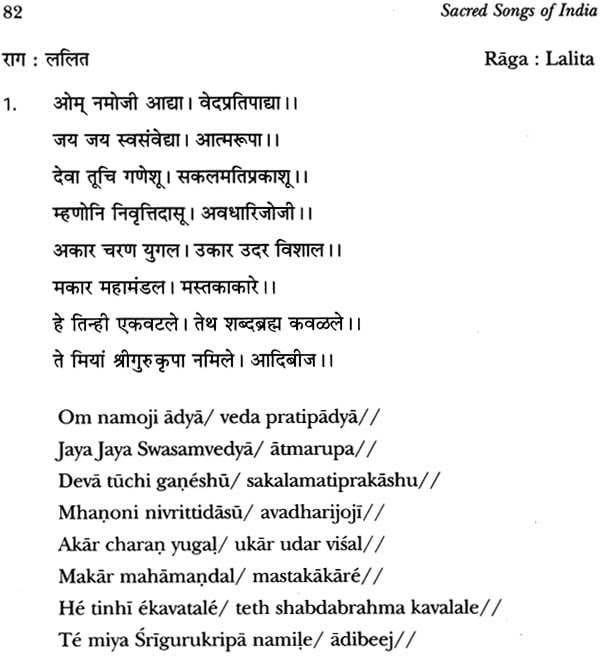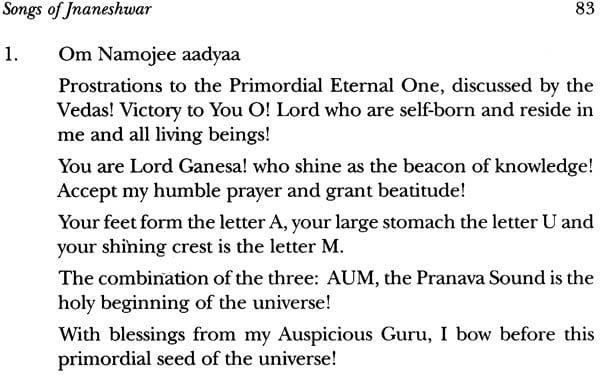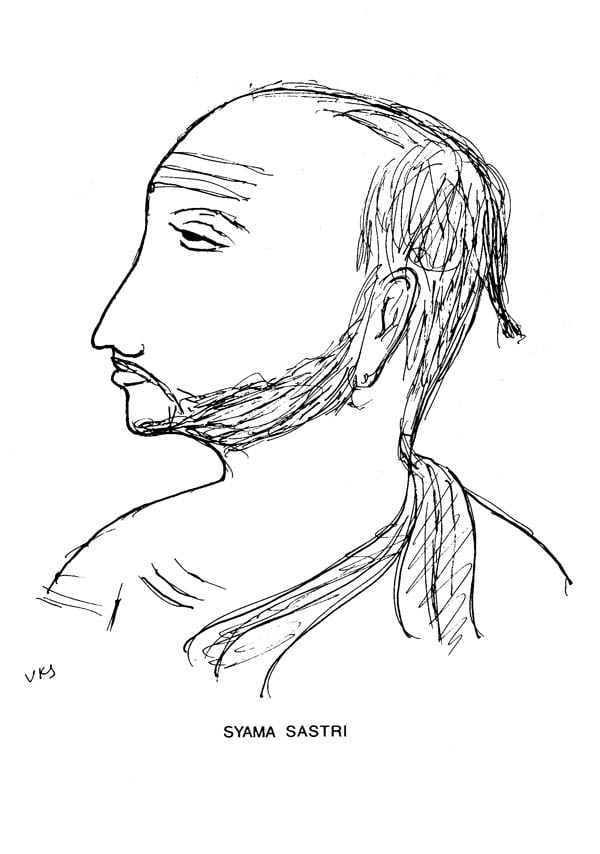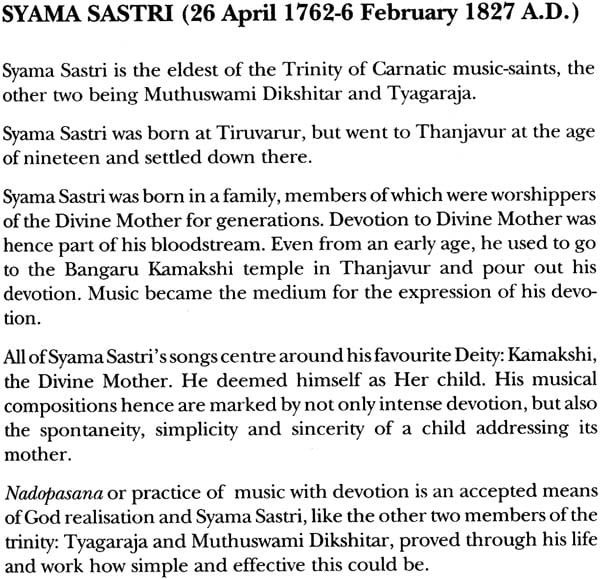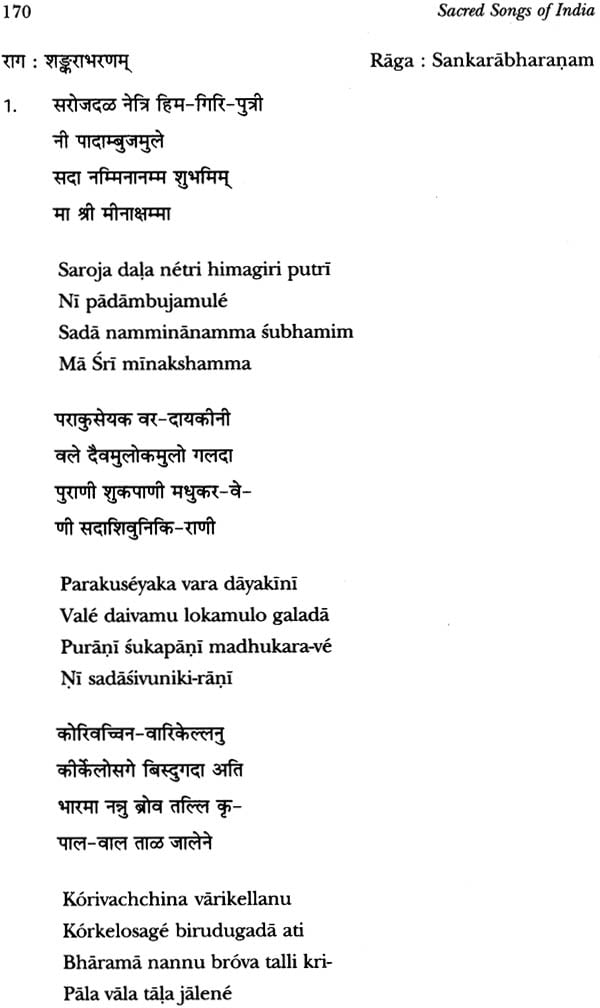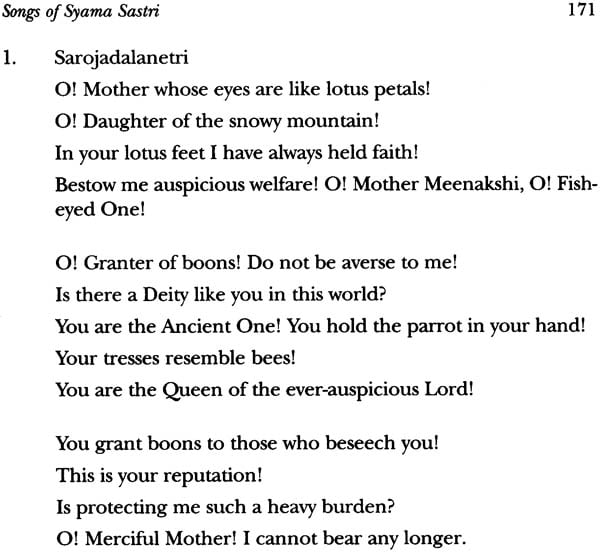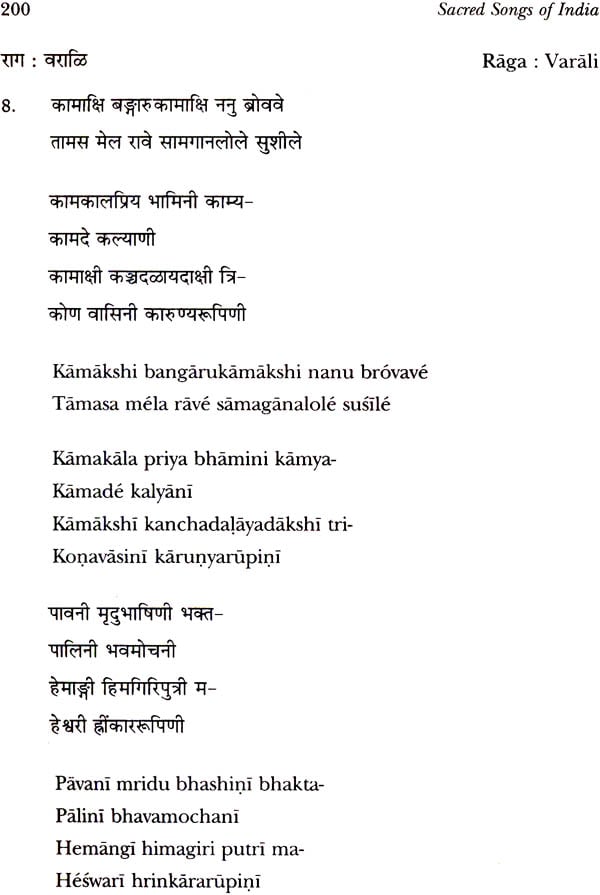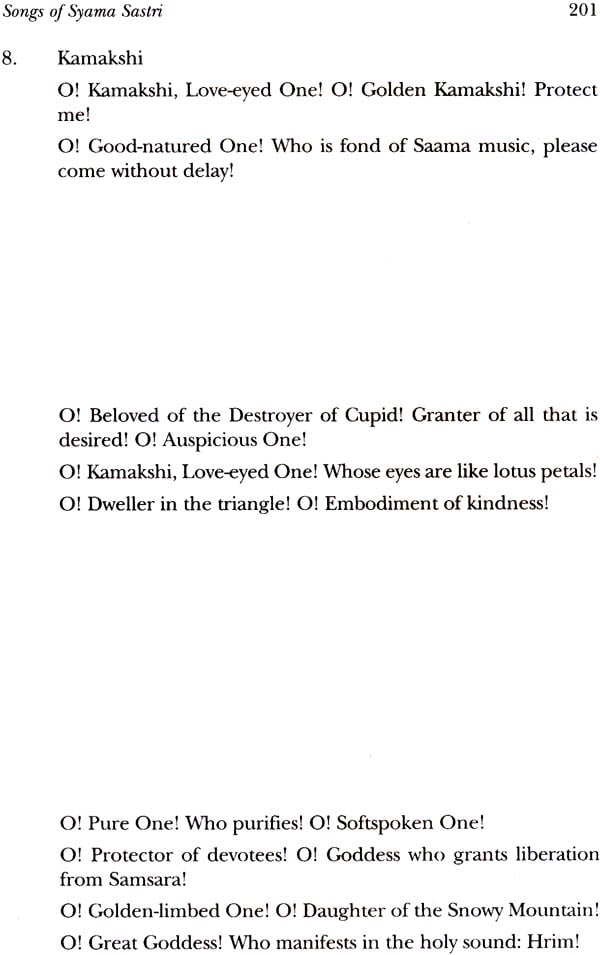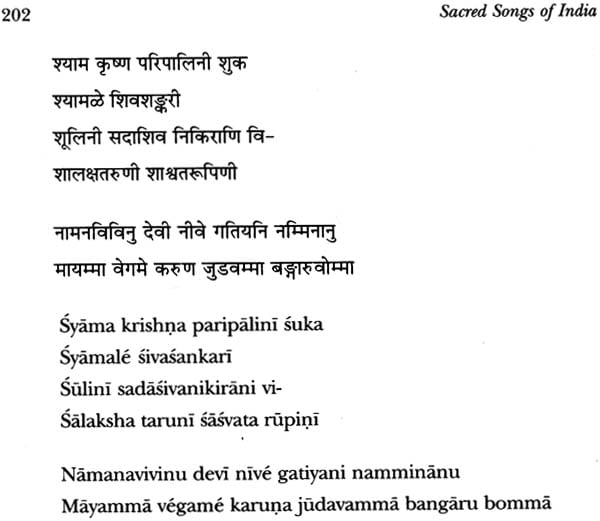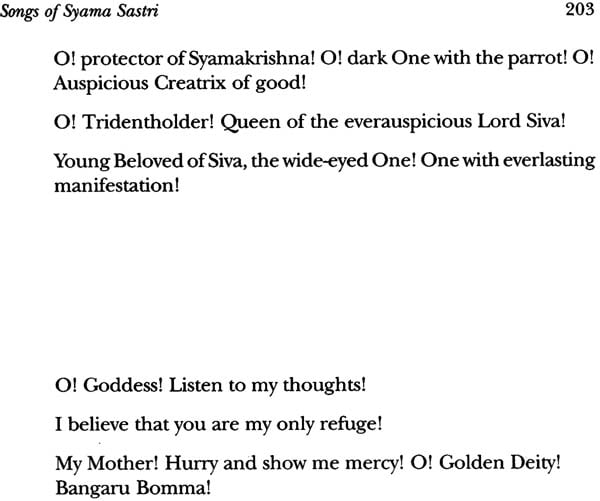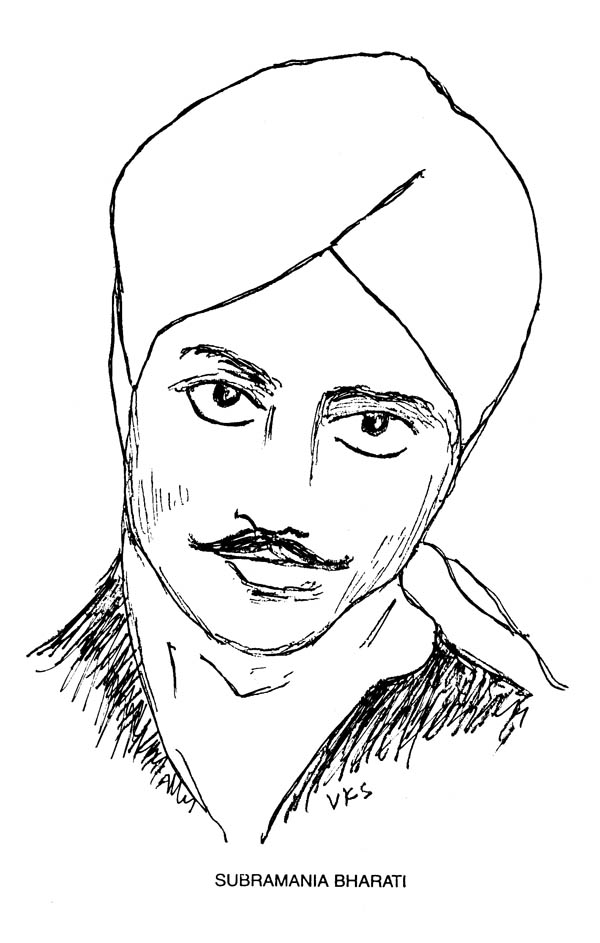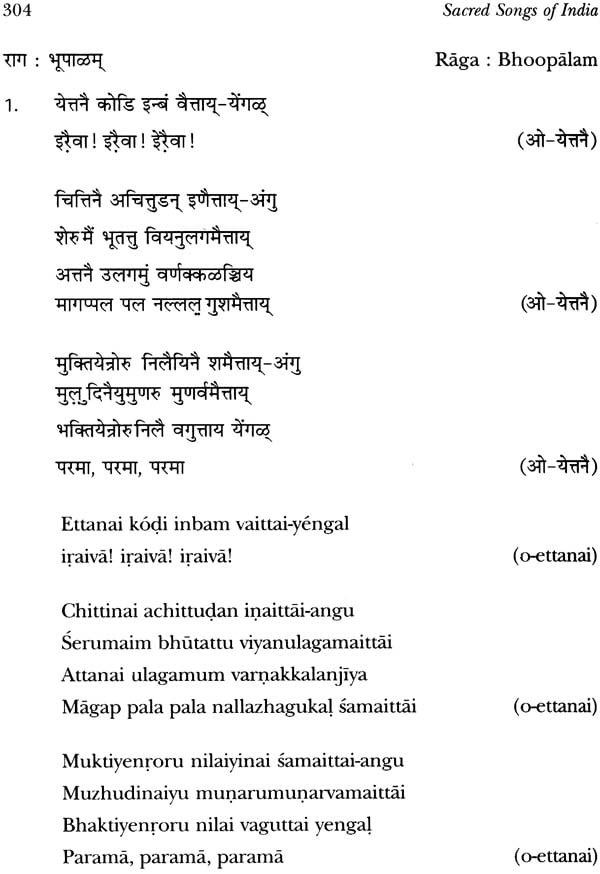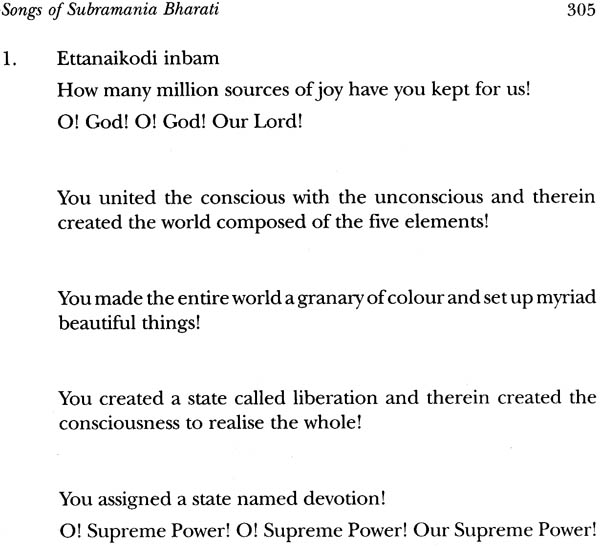
Sacred Songs of India: Devotional Lyrics of Mystics - Vol. II
Book Specification
| Item Code: | IDE512 |
| Author: | V.K. Subramanian |
| Publisher: | ABHINAV PUBLICATION |
| Language: | Sanskrit Text With Transliteration and English Translation |
| Edition: | 1999 |
| ISBN: | 8170173663 |
| Pages: | 371 |
| Cover: | Hardcover |
| Other Details | 8.7 |
| Weight | 580 gm |
Book Description
THE SACRED SONGS OF INDIA VOLUME TWO, like volume one, encompasses selections from the lifework of ten mystic poet-musician-saints of India, spanning twelve centuries. These poet sages came from different region of India and sang different languages , but they were all mystics who sought and attained direct communication with God as the intangible, omniscient, omnipresent Power or in diverse manifestations of Divinity in personalised forms celebrated in the myths and legends of India and sanctified in the various temples of India which provided the inspiration for their songs.
The mystic poet-sages included in this volume are: Manikkavachakar, Jnaneshwar, Narsi Mehta, Annamacharya, Syama Sastri, Muthuswami Dikshitar, Swati Tirunal, Rabindranath Tagore, Subramania Bharati and Papanasam Sivan. Manikkavachakar, Subramania bharati and Papanasam Sivan sang in Tamil, Muthuswami Dikshitar and Swati Tirunal in Sanskrit, Syama Sastri and Annamacharya in Telugu, Jnaneshwar in Marathi, Narsi Mehta in Gujarat and Rabindranath Tagore in Bengali.
Their diverse musical compositions imbued with God-intoxication and mysticism are presentd on a common platter, in a common language to be savoured by people all over the world, irrespective of their religioun, race, language or nationality. The SACRED SONGS OF INDIA VOLUME TWO, like the earlier volume, will be an inexhaustible repertoire for all performing artistes in the field of music, dance, drama or ballet. Scholars of Indology will find it a precious reference source.
The book will be a source of inspiration, spiritual and aesthetic, to all, wherever they live: in the continents of Euro-Asia, Africa of the continents across the Atlantic.
Vadakaymadom Krishnaiyer Subramanian (b. 1930, Kerala, India) is an eminent Indian scholar, whose life mission is to present to the world treasures of ancient Indian, in the fields of art, literature, philosophy and reiligion.
He has already translated several ancient texts into English.
These include: Saundaryalahari, Sivanandalahari, Sacred Songs of India, Maxims of Chanakya, Sri Rudraprasna.
As a consultant for holistic health and spiritual development, he has spelt out the Hindu regiments in this regard in his popular book: The Holistic way to Health, Happiness and Harmony.
Subramanian's prolific literary output covers a variety of subject ranging from astrology to art. He has been an astroplamic counsellor for over 35 years.
A retired officer of the Indian Audit and Accounts Service (Which he joined in 1953), Subramanian is also a reputed painter, who has held 22 one-man shows and whose paintings (some of them in the Chandigarh Museum) have won wide acclaim from leading art critics of India.
Subramanian, who has travelled extensively in Indian, now lives in the United States of America.
This sequel to the first volume of the Sacred Songs of India has been prompted by the favourable response received by its predecessor.
The Sacred Songs of India, Volume Two, like volume one, encom- passes selections from the lifework of ten mystic poet-musician- saints of India spanning twelve centuries. These poet-sages came from different regions of India and sang in different languages, but they were all mystics who sought and attained direct communication with God as the intangible, omniscient, omnipresent Power or in diverse manifestations of Divinity in personalised forms celebrated in the myths and legends of India.
As in volume one, the selection of sacred songs included in this volume is arbitrary, incomplete and whimsical.
Though God-intoxication is a running thread in the songs of this volume, as in the first, there are some differences I would like to highlight for the benefit of my readers.
The songs in the first volume focussed on one Deity: Krishna who is also Rama.
The songs in the present volume are hymns of praise to other manifestations of Divinity as well: like Siva, the Auspicious One, Sakti, the Divine Mother, Ganesa the darling deity and Kumara or Kartikeya or Subrahmanya, the embodiment of youth and beauty and valour, the favourite Deity in most of Tamil Nadu. God is also addressed in the abstract by poet-singers like Rabindranath Tagore.
The mystic poets, whose songs are included in this volume, are:
Manikkavachakar, the Saivite saint who lived earlier than the 9th century A.D.
Jnaneshwar, the famous Maharashtra saint who lived in the 13th century A.D. (1275-1296 A.D.)
Narsi Mehta, the saint from Gujarat who lived in the 15th century (1414-1480 A.D.)
Annamacharya, the Telugu saint-poet who also lived in the 15th century (1424-1503 A.D.)
Syama Sastri, one of the Trinity of Carnatic music (1762-1827 A.D.)
Muthuswami Dikshitar, the Tamil music composer, a contemporary of Syama Sastri and also one of the Trinity ofCarnatic music (1775- 1835 A.D.)
Swati Tirunal, the Maharaja of Travancore, who lived in the 19th century (1813-1846 A.D.)
Rabindranath Tagore, the great Nobel-Laureate, who belongs to the 20th century (1861-1941 A.D.)
Subramania Bharati, a contemporary of Tagore, who, apart from being a great patriot, was also a mystic poet who sang of the glories of his beloved Deities (1882-1921 A.D.)
Papanasam Sivan, the South Indian composer who was very much a 20th century Tamil musical icon (1890-1973 A.D.)
The songs of Manikkavachakar are soaked in bridal mysticism, as those of Andal, presented in the first volume, though the Deities idolised are different.
The approach of Jnaneshwar, who lived in the 13th century, towards the universe as a joyful expression of God is the same as that of Rabindranath Tagore and Subramania Bharati of the 20th century.
The various temples of India provided the inspiration for the songs of Manikkavachakar, Jnaneshwar, Annamacharya, Syama Sastri, Muthuswami Dikshitar, Swati Tirunal, and Papanasam Sivan. The songs of arsi Mehta are the culmination of the Bhakti movement which started in the 7th century in South India, with the Alwars and Nayanars.
Manikkavachakar, Subramania Bharati and Papanasam Sivan sang in Tamil, Muthuswami Dikshitar and Swati Tirunal in Sanskrit, Syama Sastri and Annamacharya in Telugu,Jnaneshwar in Marathi, arsi Mehta in Gujarati and Rabindranath Tagore in Bengali.
These diverse musical compositions imbued with God-intoxication and mysticism are presented on a common platter, in a common language to be savoured by people all over the world, irrespective of their religion, race, language or nationality.
Listening to these marvellous songs set in melodious tunes is a spiritual experience that enthralls and elevates everyone.
D
| Acknowledgements | 11 | |
| Introduction | 13 | |
| 1. | Songs of Manikkavachakar (9th Century A. D.) -30 Songs | 15 |
| 2. | Songs of Jnaneshwar (1275-1296 A. D.) -10 Songs | 79 |
| 3. | Songs of Narsi Mehta (1414-1480 A. D.) -10 Songs | 105 |
| 4. | Songs of Annamacharya (1424-1503 A. D.) -10 Songs | 129 |
| 5. | Songs of Syama Sastri (1762-1827 A. D.) | 167 |
| 6. | Songs of Muthuswami Dikshitar (1775-1885 A. D.) | 213 |
| 7. | Songs of Swati Tirunal (1813 A. D.-1846 A. D.) | 237 |
| 8. | Songs of Rabindranath Tagore (1861 A. D-1941 A. D.) | 277 |
| 9. | Songs of Subramania Bharati (1822 A. D.- 1921 A. D.) | 301 |
| 10. | Songs of Papanasam Sivan (1890 A. D.-1973 A. D.) | 347 |
